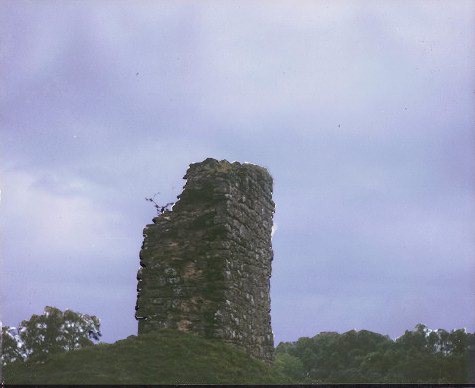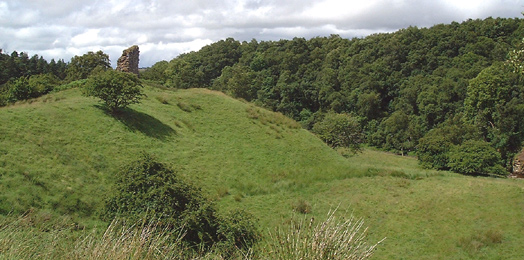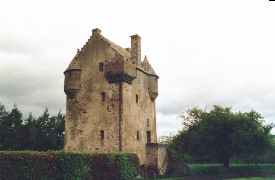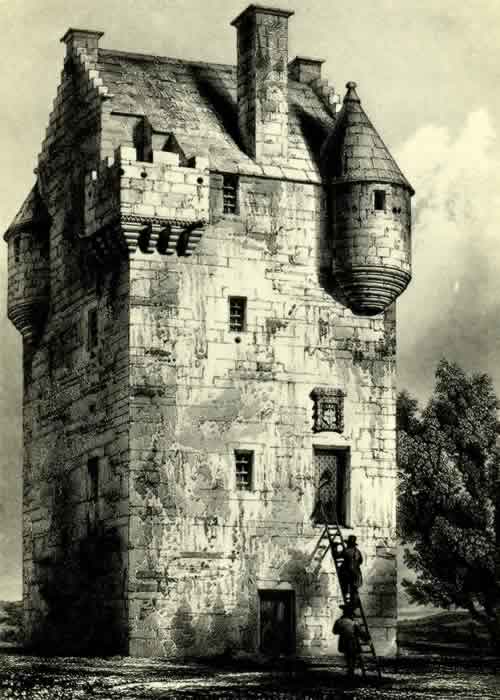To Index
Kyle Castles
Ayrshire
Half-a-mile above Dalblair, on an elevated point of land at the confluence of Guelt and Glenmuir Waters, stands the ruin of Kyle Castle. The extent of the entire building (which was probably a square tower [Scottish Tower House]) cannot now be ascertained, but a wall of great thickness testifies to its formidable strength. Examining the mortar in the wall, which is as hard as stone, it has the appearance of standing for thousands of years to come, and the wonder is how it can be so old as to have crumbled to what it is. There being no remains of any other castle of this name in Kyle, it may safely be regarded as the residence of the traditional King of Kyle, and probably the only genuine relic of the old monarchy now in existence. It looks much, too bare for Royalty now, but we must take into calculation the evidences of this having at one time been the heart of a great forest. All east of this is moorland, clad with bent, heath, and sprotts…
(source Ayrshire Roots Website)
In 1535 an Act of Parliament required every landowner over a certain value to build a tower or castle to defend his lands. It is possible that the current Kyle Castle was built during this period. However, the registry of castles in Scotland lists Kyle Castle as an early 15th century keep. The tower was once home to the Cunninghame family and later passed tot he Stuarts of Bute.
There are accounts of a sketch of the standing castle being kept at “the church at Coylton,” however there are no records as to the whereabouts of the sketch now. The sketch was said to depict a four-storied Scottish Tower House with four rooms connected by a staircase. The Castle ruin and surrounding lands are still owned by the Marquis of Bute.
The Ruin of Kyle Castle Today:


(photo source, Cumnock.net)
More Photos of Kyle Castle Ayrshire
There are only scant remains of Kyle Castle, a rectangular keep which has measured 14.0m x 7.0m externally. A fragment of wall, 6.1m long, 5.5m high and 1.8, thick, forms the N side of the keep, while the remaining walls are a mass of earth and stone. The wall is of ashlar masonry - typical construction of a 15th - 16th c keep. It is situated on a flat-topped spur which may have had a surrounding courtyard wall as vague mounds appear here and there on the edge. On the W extremity, there is a narrow 'covered way' which curved up to the keep; this may be a later construction.
Visited by OS (JLD) 30 November 1955
Royal Commission on the Ancient and Historical Monuments of Scotland
National Monuments Record of Scotland
John Sinclair House, 16 Bernard Terrace, Edinburgh EH8 9NX
Tel: +44 (0)131 662 1456 | Fax: +44 (0)131 662 1499
Email: nmrs@rcahms.gov.uk | Website: www.rcahms.gov.uk
An example of a Four Story Scottish Tower House (Coxton Tower):

Drawing of Coxton Tower

Kyle (Deeps)
Castle -- near Killurin, Co.
Wexford ,
Ireland --- No photo as of yet.
---
Mike Salter in "Castles and Strongholds of Ireland" describes a Kyle Castle with an alternate name of Deeps' Castle. It is a four-story tower measuring 14.7m long by 11m wide, and lies by the river Slaney. The book depicts a diagram of the plan of Kyle Castle, but offers no origin of its name(s). Salter speculates a late date for this tower, but offers no timeframe.
One write-up mentions, "Passing under the Deeps bridge we pass Killurin on the west bank and the gaunt ruin of the Deeps castle can be seen on the east bank as we round a bend in the river. Strategically placed on the river Slaney this castle must have played an important role in the history of medieval Wexford and was retained in the hands of the Lord of Wexford. The builder is not known but in the sixteenth century it passed into the ownership of the Devereux family. After the Cromwellian campaign the manor of the Deeps passed to the Randall's who were associated with the establishment of the Society of Friends (Quakers) in Co Wexford. The first Quaker meeting in the county was held at Edermine four miles north of the Deeps, in 1657. In 1690, after the Battle of the Boyne, King James II visited the Deeps Castle on his way south to Duncannon."
Kyle appears to be a place name of a village and estate nearby. Kyle estate, on the river Slaney, is described as the seat of W. Harvey, Esq. in Samuel Lewis' Topographical Dictionary, located in the civil parish of Kilpatrick (aka Kyle).